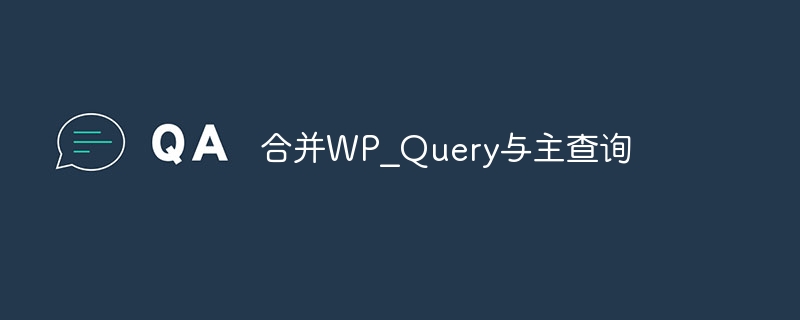合併WP_Query與主查詢
- PHPz原創
- 2023-08-30 19:57:17931瀏覽

到目前為止,在本系列中,您已經學習如何使用 WP_Query 建立在主題或外掛程式中使用的自訂查詢。
在大多數情況下,您將使用 WP_Query 以及一組全新的參數,這些參數與主查詢中的參數分開,但是如果您想在參數中包含主查詢怎麼辦?
您可能想要執行此操作的範例包括:
- 在類別或分類頁面上,只顯示一種貼文類型的貼文
- 在類別頁面上,顯示包含目前類別和其他類別或標籤或分類術語的貼文
- 在貼文類型的頁面上,僅顯示具有特定元資料的貼文
我可以繼續說下去,有很多機會可以將主查詢與您自己的自訂查詢結合。
我將透過三個範例來示範這一點:第一個範例是一個帶有一個循環的簡單範例;第二個將使用foreach 輸出多個循環,每個循環對應一種貼文類型;第三個將使用兩個單獨的查詢在類別存檔上輸出兩種貼文類型。
根據主查詢定義變數
但是,您要將主查詢與 WP_Query 結合起來,您需要以一種易於在 WP_Query 中使用的方式儲存目前查詢物件論點。最簡單的方法是將其分配給一個變數。
在定義 WP_Query 參數之前執行此操作,如下所示:
$mainquery = get_queried_object();
get_queried_object() 函數傳回目前查詢的對象,無論該對像是什麼。在單一帖子上,它只會返回帖子對象,而在存檔上,它將返回類別、標籤、術語對像或與存檔相關的任何對象。它傳回查詢物件的ID。
然後,您可以在 WP_Query 參數中使用此 $mainquery 變數。現在讓我們來看一些範例。
範例 1:在類別頁面上僅顯示一種貼文類型的貼文
假設您的網站新增了自訂貼文類型,並且您已為該自訂貼文類型啟用了類別。在每個類別的類別存檔上,您不想顯示帖子:相反,您想顯示新帖子類型的帖子 - 讓我們將其稱為 product。
您的查詢可能如下所示:
<?php
$mainquery = get_queried_object();
$args = array (
'category_name' => $mainquery->slug,
'post_type' => 'product'
);
// Custom query.
$query = new WP_Query( $args );
// Check that we have query results.
if ( $query->have_posts() ) {
// Start looping over the query results.
while ( $query->have_posts() ) {
$query->the_post();
// Contents of the queried post results go here.
}
}
// Restore original post data.
wp_reset_postdata();
?>
由於我上面使用的 category_name 參數是以類別 slug 為參數,因此需要在變數後面加上 ->slug 來輸出類別 slug。
這為您提供了一個查詢,該查詢從具有當前查詢類別的資料庫中獲取 product 帖子類型的帖子。您可以在 category.php 頁面範本上使用它。
注意:您也可以使用 pre_get_posts 掛鉤修改主查詢,並結合條件函數檢查類別檔案來實現此結果。
範例2:主查詢與WP_Query和foreach組合輸出多個循環
下一個範例將輸出目前類別頁面的所有帖子,但不是將它們全部顯示在一個區塊中,而是按帖子類型將它們分開。
這意味著您可以使用 CSS 將貼文類型分類為頁面上的區塊或列,或者只是將它們分成不同的清單。
為此,您可以使用以下程式碼:
<?php
$mainquery = get_queried_object();
$post_types = get_post_types();
foreach ( $post_types as $post_type ) {
$args = array(
'category_name' => $mainquery->slug,
'post_type' => $post_type
);
// Custom query.
$query = new WP_Query( $args );
// Check that we have query results.
if ( $query->have_posts() ) {
// Start looping over the query results.
while ( $query->have_posts() ) {
$query->the_post();
// Contents of the queried post results go here.
}
}
// Restore original post data.
wp_reset_postdata();
}
?>
這使用了我們之前使用過的$mainquery 變量,但它還添加了一個$post_types 變數來儲存在網站上註冊的所有帖子類型,以及一個$post_type 變數依序儲存每個單獨的貼文類型。
範例 3:針對兩種貼文類型的兩個單獨查詢
最後一個範例與第二個範例類似,但將貼文類型分為兩個單獨的查詢,每個查詢都有自己不同的循環。這使您可以更好地控制每個內容的顯示內容,因此您可以以不同於產品的方式顯示帖子,可能包括產品的特色圖片或為它們提供不同的佈局。
假設您的網站註冊了 product 貼文類型,並為其啟用了類別,並且您也在撰寫具有相同類別的部落格文章。在每個類別存檔頁面上,您希望顯示最近的十篇帖子,然後您希望顯示同一類別中所有產品的清單。
為此,您可以使用類似以下程式碼:
<?php
$mainquery = get_queried_object();
// First query arguments for posts.
$args = array (
'category_name' => $mainquery->slug,
'post_type' => 'post',
'posts_per_page' => '10'
);
// Custom query.
$query = new WP_Query( $args );
// Check that we have query results.
if ( $query->have_posts() ) {
// Start looping over the query results.
while ( $query->have_posts() ) {
$query->the_post();
// Contents of the queried post results go here.
}
}
// Restore original post data.
wp_reset_postdata();
// Second query arguments for products.
$args = array (
'category_name' => $mainquery->slug,
'post_type' => 'product',
'posts_per_page' => '-1'
);
// Custom query.
$query = new WP_Query( $args );
// Check that we have query results.
if ( $query->have_posts() ) {
// Start looping over the query results.
while ( $query->have_posts() ) {
$query->the_post();
// Contents of the queried post results go here.
}
}
// Restore original post data.
wp_reset_postdata();
?>
然後,您可以以不同的方式編寫每個循環,以便為每種貼文類型輸出不同的資料。
摘要
從上面的範例中可以看出,使用WP_Query 不僅可以建立與主查詢分離的完全自訂查詢,還可以合併目前查詢的物件並在存檔頁面上建立更強大的查詢。
上面的範例也可以使用其他存檔類型來完成:用於分類、作者、日期等。看看你是否能想出更多的可能性!
以上是合併WP_Query與主查詢的詳細內容。更多資訊請關注PHP中文網其他相關文章!

